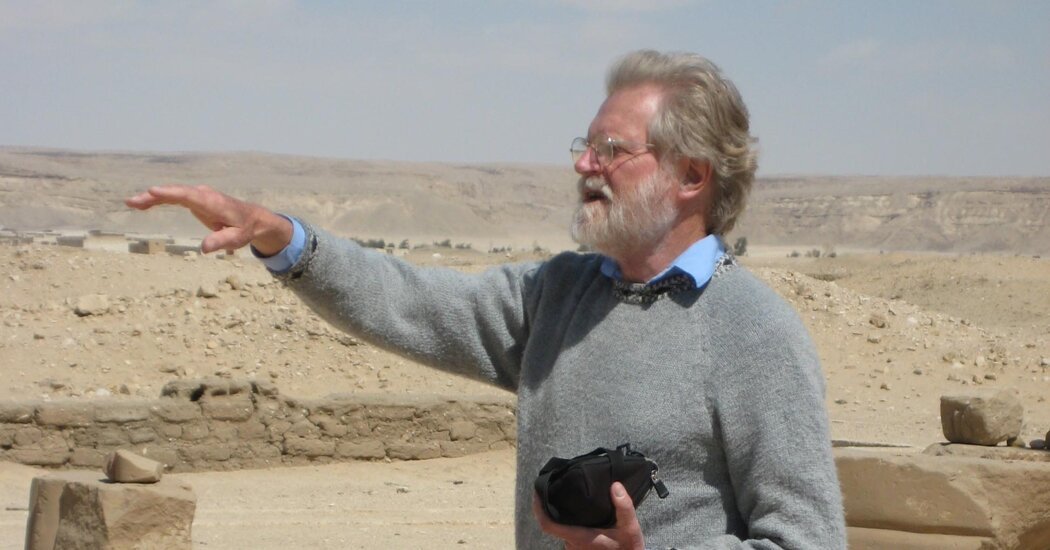Barry Kemp, an archaeologist whose decades of painstaking digging at the abandoned capital of a mysterious pharaoh helped revolutionize our understanding of how everyday ancient Egyptians lived, worked and worshiped, died on May 15 in Cambridge, Britain, one day after his 84th birthday.
The death was announced by the Amarna Project, an archaeology nonprofit where Mr. Kemp was director. It did not specify a cause or exact location.
Almost from the moment he arrived to teach at Cambridge University in 1962, fresh out of college, Mr. Kemp was a phenomenon. When he was just 26, he published an article in The Journal of Egyptian Archaeology that greatly shifted the debate about a set of burial structures from around 3000 B.C., showing they were most likely forerunners to the pyramids.
Much of his work had little to do with the pharaohs, though. He was among the first to apply the questions of social history, in which scholars explore the lives of everyday people in the past, to ancient Egypt.
“What I wanted to do was to apply modern and inevitably slower methods of excavation and to study with a view to learning more about the life of the city,” he told Humanities magazine in 1999. “My interest is much more in the power of archaeology to reveal the more basic aspects of society.”
Those visiting Mr. Kemp in the field would find an archaeologist out of central casting: tall and sturdy, with a big bushy beard and a perpetual deep tan. He was known for his exhaustive attention to tiny details, digging for subtle bits of evidence — fossilized fleas, swatches of clothing, even the residue from 3,000-year-old beer, which Mr. Kemp helped reverse-engineer, then brew, in 1996. (A colleague said it tasted like a malty chardonnay.)
In a field as vast as Egyptology, where scholars by necessity must narrowly focus their investigations, Mr. Kemp was a generalist, able to bring new insight to an array of subfields.
“He was just one of the huge ones, in a way that we don’t have scholars in that field any longer,” Laurel Bestock, an archaeologist at Brown University who worked with him in the field, said in a phone interview. “His work touches every corner of Egyptology.”
In between field trips he churned out a steady stream of papers, journal articles and books, including “Ancient Egypt: Anatomy of a Civilization,” which first appeared in 1989 and which he thoroughly revised in two subsequent editions; it remains required reading for anyone interested in Egyptology.
Mr. Kemp is most closely associated with a site called Amarna, about 200 miles south of Cairo, far from what most tourists see when they come to explore the remnants of ancient Egypt.
Amarna was the capital of the Pharaoh Akhenaten, who had assumed the throne in 1353 B.C. He practiced an early form of monotheism, worshiping the sun god Aten, and he dragged up to 50,000 of his subjects with him to build a new city in the desert.
Amarna was seven miles long and three miles wide, arranged around palaces and temples, one of which, the Great Aten Temple, was half a mile in width. But its lack of potable water, and Akhenaten’s deep unpopularity at his death around 1335 B.C., led Egyptians to flee back north, leaving Amarna to the desert.
Precisely because of its forbidding location, Amarna escaped the fate of sites in the more urban north, which were plundered and built over. It is considered an Egyptian version of Pompeii, the Roman city frozen in time after being buried in volcanic ash in 79 A.D.
Amarna was also the perfect place for an investigation like Mr. Kemp’s into the lives of everyday Egyptians.
At first glance its palaces and temples tell a story of abundant riches. But over the decades, he and his team unearthed cemeteries, workshops and villages that revealed a more somber tale: that of the everyday people, including slaves, who toiled and died to make all that splendor possible.
Ancient Egypt was never a great place to be a laborer, but remote, sun-seared Amarna was especially brutal. Most died by their early 20s from malnutrition, spinal injuries and plague.
“The bones reveal a darker side to life,” Mr. Kemp told the BBC in 2008, “a striking reversal of the image that Akhenaten promoted, of an escape to sunlight and nature.”
Barry John Kemp was born on May 14, 1940, in Birmingham, Britain. His father, Ernest, was a traveling salesman, and his mother, Norah (Lawless) Kemp, managed the home.
His father served in Egypt with the British Army during World War II, and the postcards and photographs of pyramids and palaces that he sent home inspired his son’s early interest in archaeology.
Mr. Kemp studied Egyptology and Coptic at the University of Liverpool and graduated in 1962, the same year he began teaching at Cambridge, where he spent his entire career. He received a master’s degree in Egyptology from Cambridge in 1965.
Mr. Kemp’s first two marriages ended in divorce. He is survived by his third wife, Miriam Bertram, an Egyptologist with whom he worked closely; his daughters Nicola Stowcroft, Victoria Kemp and Frances Duhig; two granddaughters; and one great-granddaughter.
He made his first trip to Amarna in 1977, and returned every year until 2008. Even after he slowed down, he continued to trek to the site as often as he could.
Mr. Kemp summarized much of his fieldwork in his 2012 book “The City of Akhenaten and Nefertiti: Amarna and Its People.” He had much to say, and while most of it remained within the confines of scholarly discourse, he did have one warning for would-be autocrats like Akhenaten.
“The danger of being an absolute ruler,” he wrote, “is that no one dares tell you that what you have just decreed is not a good idea.”

